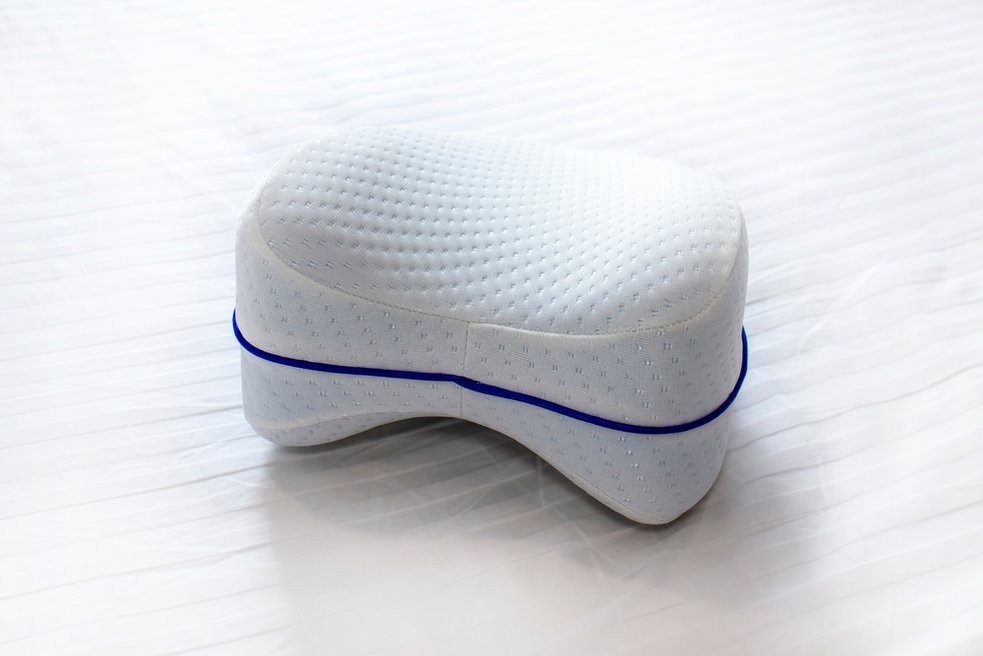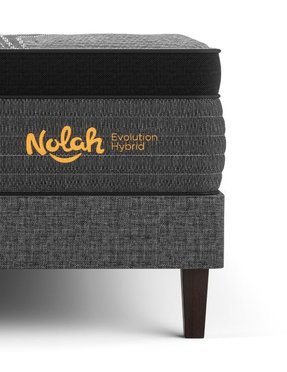8 Benefits to Sleeping With a Pillow Between Your Knees
Can’t seem to get comfortable in bed? An extra pillow may be the missing piece. Sleeping with a pillow between your knees can help position your body just right, aligning your spine and alleviating pressure in all the right places.
Your sleep position should align your spine while preventing aches and pains. Finding the right mattress for your sleep position and physique is your best bet for maximum comfort and support, but using a pillow between your knees can help you get by until then. If you’ve already found your perfect mattress, the extra pillow can still take your sleep comfort to the next level with extra pressure relief and stability.
In this guide, we’ll dive deep into the benefits of knee pillows, how to position the pillow, and how to choose the right knee pillow for your needs.
The Health Benefits of Sleeping with a Pillow Between Your Knees
Many people instinctively find an extra pillow essential to sleep. If you’re one of those people, you may have asked yourself, why do I sleep with a pillow between my knees?
While you may recognize that this position helps you sleep more comfortably, you may not realize exactly why it feels good to sleep this way. If you don’t already sleep with a knee pillow, you may want to start after you learn about this simple habit’s many benefits.
1. Prevents Knee Pain for Side Sleepers
If you're a side sleeper, you probably know what it's like to have your knees knock together all night. Sleeping with a pillow between your knees keeps them separated and cushions these sensitive joints. The pillow also provides extra pressure relief to the surrounding area. Many side sleepers find that the pillow stabilizes their position and keeps them from moving around in their sleep.
2. Relieves Muscle Cramps or Tension
Awkward sleeping positions can strain muscles or worsen existing cramps. Sleeping on your side with a pillow between your legs keeps your knees aligned and supported for a more comfortable sleep. The pillow stabilizes your legs, preventing awkward twisting and turning throughout the night. It also keeps one knee neatly stacked, one on top of the other, promoting proper pelvic and spinal alignment.
3. Reduces Lower Back Pain
If you sleep on your back, sleeping with a pillow underneath your knees or lower back limits strain on your spine. This spinal alignment is crucial to quality sleep and can prevent you from waking up with aches and pains.
Lower back pain can also be a sign of sciatica, pain that radiates along the path of the sciatic nerve from your lower back and down your leg. If you suspect you may have sciatica, using a knee pillow for back pain can help you sleep more comfortably. (Still, be sure to talk to your doctor to identify and treat the root cause.)
4. Prevents Your Hips From Rotating
Without a knee pillow, the side sleeping position can shift your hips out of alignment and cause lower back and hip pain. This happens when the upper knee rotates toward the mattress surface, and gravity pulls it downward. Aligning your knees on top of one another with a pillow in between prevents this rotation and maintains the natural alignment of your hips. It keeps them in place and reduces pressure for side sleepers.
Aligning your knees on top of one another with a pillow in between prevents rotation and maintains the natural alignment of your hips.
5. Helps You Breathe Easier
If you have a breathing condition like sleep apnea, sleeping with a pillow between your legs can help. The knee pillow helps to align the spine, which helps open your airways. The side sleeping position is naturally beneficial to people who have sleep apnea or otherwise struggle with snoring; when you sleep on your side, gravity pulls your tongue to the side instead of to the back of the throat, which causes obstruction for back sleepers. For sleepers trying to train themselves to sleep on their side to alleviate snoring, a pillow between the knees can help reinforce the new position.
6. Improves Circulation
Have you ever slept with your arm under your pillow and woken up with a numb or tingling sensation? It can be scary to wake up feeling like your arm is no longer attached to your body, but it’s just a sign of poor blood circulation.
Adding a pillow under your knees or between your legs can resolve this issue. By raising and separating your knees, the pillow helps keep blood flowing properly through your lower body.
Back sleepers can also add a pillow under their feet to raise their legs. The elevation naturally helps circulation, as gravity pulls the blood back towards your heart.
7. Prevents Varicose Veins
Varicose veins are swollen or twisted veins that often occur in the legs. Placing a pillow under your knees or in between your legs can elevate them above your heart. This increases blood circulation, which helps treat visible varicose veins. Sleepers with poor circulation or varicose veins may also want to consider an adjustable base for comfortable leg elevation.
8. Provides Additional Support for Pregnant Women
Getting quality sleep throughout pregnancy is essential for both mom and baby. However, it can be hard to get comfortable, partially because the added weight that comes with pregnancy puts more pressure on your knee joints.
Especially during the later months of pregnancy, that joint pain can feel overwhelmingly uncomfortable. Sleeping with a pillow between your knees adds extra cushioning and support for the joints under increased pressure.
How to Sleep Properly with a Pillow Between Your Legs
Sleeping with a pillow between your knees (or under your knees if you’re a back sleeper) can have unexpected benefits. If you want to give this trick a try, keep in mind that there is a right way to position your body and keep your spine aligned.
The Right Way to Sleep with a Pillow Between the Knees
Step 1: Lay on your side with your legs curled slightly in toward your chest.
Step 2: Place a firm pillow between your knees. The pillow should be firm and high enough to lift your knee so that your hips stay parallel to one another in a neutral position. If you need to, try adding another pillow.
Step 3: If you find your body sinking into the mattress and causing your spine to curve to one side, add a pillow under your torso so that your spine stays straight while you sleep.
The Right Way to Sleep with a Pillow Under the Knees
Step 1: Lay flat on your back.
Step 2: Bend your knees slightly while keeping your buttocks and feet planted on the bed.
Step 3: Slide a pillow under your knees. Try adjusting the number of pillows until you find a comfortable position.
What to Look for in a Knee and Leg Pillow
While you don’t necessarily need a specialized knee pillow, there are options out there designed to fit the natural shape of your knees and provide the proper height and support to keep your hips in alignment.
Knee pillows specifically provide support and relieve pressure. If you find that sleeping with a pillow between your knees helps you get to sleep faster and wake up with less pain, it may be worthwhile for you to consider buying an orthopedic knee pillow.
That said, let’s go over what you should look for when shopping for a knee pillow.
Shape and Size
Knee pillows come in all shapes and sizes, from the classic hourglass to cylindrical, to heart-shaped.
Rounded or cylindrical pillows work best for back sleepers who place the pillow under their knees. Hourglass and heart-shaped pillows, on the other hand, are designed to fit between the legs as you sleep on your side. Side sleepers can also opt for a body pillow.
To choose the right pillow to support a neutral alignment, you’ll want to take your hip size into account. Heart-shaped pillows typically run smaller than hourglass ones, so people with narrower hips may find this shape more comfortable.

Firmness
Since the point of a knee pillow is to lift and separate your knees for better alignment, you don't want a pillow that's too plush. A supportive pillow will help relieve pressure on your hips and knees, so look for one that's firm but comfortable.
Since knee pillows don't typically have an objective firmness rating, you'll likely need to try it out yourself. Try to buy a pillow with a money-back guarantee so that you can return it if it doesn't work out.
Thickness
A pillow's thickness also dictates how much support it provides. When placed between your legs, the ideal pillow will have the right thickness to keep your hips parallel to one another. Heavier individuals will likely require a firmer, thicker pillow to ensure the top knee doesn't sink too far into the pillow. We suggest a pressure-relieving, moldable pillow made with foam or latex. The Adjustable Shredded Foam Pillow is a great option because it lets you adjust the filling to find the perfect thickness and firmness.
Cooling Properties
If you tend to sleep hot, you may hesitate to add another pillow to the mix. That's why some manufacturers have developed ways to keep their pillows cool. For example, breathable fabrics prevent heat from getting trapped in the pillow.
Materials
As with most things, quality materials will likely raise the price tag of a knee pillow, but it's often worth it in terms of durability and effectiveness. Look for breathable fabrics for pillow covers and soft yet supportive fill, such as shredded foam or pressure-relieving latex.
Tips and Reminders for Sleeping With a Pillow Between Knees
Sleeping with a pillow between your legs can reduce pain while offering extra sleep comfort. Just remember to keep these last few tips in mind:
- If you sleep on your side, a pillow between your knees is ideal. If you're a back sleeper, try a pillow under your lower back.
- Remember that spinal alignment is the goal of sleeping with a pillow under or between the knees, so make sure to use a pillow that offers firm support.
- Don't ignore aches and pains. Consult your doctor if the pain becomes unmanageable.
You can dramatically improve your hip and spinal alignment with the purchase of a new pillow. With this simple sleep adjustment, you can make pressure and joint pain a thing of the past.
Disclaimer: Nolah does not provide medical advice. All resources on the Nolah blog, including this article, are informational only and do not replace professional medical counsel. Talk to your doctor about any health, mental health, or sleep-related issues.
You May Also Like These Articles
Don't Sleep on Exclusive Offers
Sign up for our newsletter, and you'll be the first to know about discounts, deals, and what's new at Nolah.
Ready for Bed?
